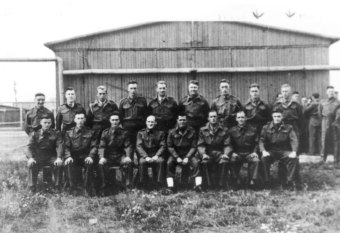E715 – Camp for British Prisoners of War

© Fritz Bauer Institute (APMO Collection / Auschwitz-Birkenau State Museum)
On the plant grounds of I.G. Auschwitz, there was a camp for British prisoners of war. It was situated in the Interessengebiet Auschwitz (Auschwitz sphere of interest), which was under SS control, but it was administered and guarded by the Wehrmacht, under the name of E715, as a work subcamp of the main camp (Stalag) VIII B in Lamsdorf (after November 1943, in Teschen), which was the largest Nazi prisoner of war camp. The British prisoners of war (POWs) were housed in Auschwitz near the construction site of the Buna plant, several hundred meters west of the Buna/Monowitz concentration camp. Through the fences they could see what went on in the Buna/Monowitz concentration camp, and they heard shots at night and saw the bodies of the men who were hanged. At the construction site, too, the British POWs encountered the concentration camp inmates.
The British POWs in E715 came from almost every country of the Commonwealth.[1] Some of them had fallen into German hands as long ago as 1940, at Dunkirk, but most had been captured in North Africa, initially by Italian troops. After Italy’s change of sides in 1943, the German Army took them to prisoner of war camps in Silesia and finally to Auschwitz. The first 200 British POWs, including Robert William Ferris, reached Auschwitz in early September 1943. In winter 1943/44, about 1,400 British POWs were interned in E715. In February and March 1944, around 800 of them were moved to Blechhammer and Heydebreck. After that time, the number of British prisoners of war in Auschwitz remained constant, at around 600.
E715 had a sick-bay of its own. The British military doctors working there were, apart from the “man of confidence,” the only officers in the camp. I.G. Farben wanted to impose on them an illness absence rate not exceeding 3 percent of the camp population. To monitor this, the I.G. Farben plant physicians Ulrich Peschel and Bonk visited E715 and ordered the invalids they classified as “fit for work” to be brought by guards to the construction site for labor. The occupancy rate of the sick-bay in E715 usually was 10 to 15 percent of the camp inmates.
Through illegal radio reception, the British POWs learned about the progress of the war. They tried to pass on to the concentration camp prisoners information about key events such as the Allied landing in Normandy on June 6, 1944. Some, including Charles Joseph Coward, smuggled out news about the happenings in letters to the British War Office or informed Swiss representatives of the Red Cross, who paid two visits to E715 in summer 1944.
On Sunday, August 20, 1944, the U.S. Army Air Force made its first air strike on I.G. Auschwitz. One bomb fell into the camp of the British prisoners of war, which had only inadequate air-raid shelters, and 39 British POWs lost their lives as a result. On subsequent bombing missions up to the end of 1944, the camp was not struck again, despite its proximity to the construction site.
As of December 1944, the British POWs in E715 ceased to receive the Red Cross parcels due them in accordance with the Geneva Convention. As the Red Army was approaching Auschwitz in January 1945, the Wehrmacht closed E715 on January 21, 1945, and made the British prisoners of war march through Poland and Czechoslovakia in the direction of Bavaria. Here the British POWs received better treatment than the concentration camp prisoners forcibly driven by the SS on the death march. But there was little food for them on their four-month trek, and Red Cross parcels reached the POWs only rarely. In April 1945, the U.S. Army freed the British prisoners of war from Auschwitz in Stalag VII A in Moosburg.
(MN; transl. KL)
















